This article needs additional citations for verification .(February 2015) |
The New Life Version (NLV) of the Bible is a simplified English translation by Gleason and Kathryn Ledyard. [1]
This article needs additional citations for verification .(February 2015) |
The New Life Version (NLV) of the Bible is a simplified English translation by Gleason and Kathryn Ledyard. [1]
The translation was born out of the Ledyards' missionary work in the Canadian Arctic to First Nations populations, who did not always speak English fluently. The NLV uses a limited vocabulary of about 850 words, not including proper names. This was done to make the text easier to read and understand, a goal that the Ledyards felt was not adequately met by existing English translations of the Bible. [2]
The NLV uses gender-specific language and uses no contractions. Confusing wording is avoided. Weights and measures are worded so that anyone can understand them; For example, Noah's ark is described as being: "...as long as 150 long steps, as wide as twenty-five long steps, and eight times taller than a man." [3]
The translation of the New Testament was completed in 1969, and the complete NLV Bible with Old and New Testaments was first published in 1986.[ citation needed ]
The NLV Bible is published by Christian Literature International. It can be accessed online. [4]
King James Version of John 3:16-17 : "For God so loved the world that he gave his only begotten Son that whosoever believeth in him should not perish but have everlasting life. For God sent not his Son into the world to condemn the world; but that the world through him might be saved."
New Life Version of John 3:16-17 : "For God so loved the world that He gave His only Son. Whoever puts his trust in God's Son will not be lost but will have life that lasts forever. For God did not send His Son into the world to say it is guilty. He sent His Son so the world might be saved from the punishment of sin by Him."
King James Version of Genesis 1:1-3 : "In the beginning God created the heaven and the earth. And the earth was without form, and void; and darkness was upon the face of the deep. And the Spirit of God moved upon the face of the waters. And God said, Let there be light: and there was light."
New Life Version of Genesis 1:1-3 : "In the beginning God made from nothing the heavens and the earth. The earth was an empty waste and darkness was over the deep waters. And the Spirit of God was moving over the top of the waters. Then God said, “Let there be light,” and there was light."
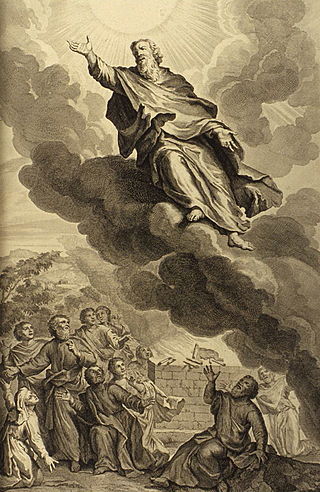
Enoch is a biblical figure and patriarch prior to Noah's flood, and the son of Jared and father of Methuselah. He was of the Antediluvian period in the Hebrew Bible.

Biblical cosmology is the account of the universe and its laws in the Bible. The Bible was formed over many centuries, involving many authors, and reflects shifting patterns of religious belief; consequently, its cosmology is not always consistent. Nor do the biblical texts necessarily represent the beliefs of all Jews or Christians at the time they were put into writing: the majority of the texts making up the Hebrew Bible or Old Testament in particular represent the beliefs of only a small segment of the ancient Israelite community, the members of a late Judean religious tradition centered in Jerusalem and devoted to the exclusive worship of Yahweh.
An Historical Account of Two Notable Corruptions of Scripture is a dissertation by the English mathematician and scholar Isaac Newton. This was sent in a letter to John Locke on 14 November 1690. In fact, Newton may have been in dialogue with Locke about this issue much earlier. While living in France, Locke made a journal entry, dated 20 December 1679, where he indicates that while visiting the library at Saint-Germain-des-Prés he saw:
[T]wo very old manuscripts of the New Testament, the newest of which was, as appeared by the date of it, at least 800 years old, in each of which 1 John, ch.v. ver. 7, was quite wanting, and the end of the eighth verse ran thus, "tres unum sunt;" in another old copy the seventh verse was, but with interlining; in another much more modern copy, ver. 7 was also, but differently from the old copy; and in two other old manuscripts, also, ver. 7 was quite out, but as I remember in all of them the end of the eighth verse was "tres unum sunt."
Chaos is the mythological void state preceding the creation of the universe in Greek creation myths. In Christian theology, the same term is used to refer to the gap or the abyss created by the separation of heaven and earth.

Mark 12 is the twelfth chapter of the Gospel of Mark in the New Testament of the Christian Bible. It continues Jesus' teaching in the Temple in Jerusalem, and contains the parable of the Wicked Husbandmen, Jesus' argument with the Pharisees and Herodians over paying taxes to Caesar, and the debate with the Sadducees about the nature of people who will be resurrected at the end of time. It also contains Jesus' greatest commandment, his discussion of the messiah's relationship to King David, condemnation of the teachers of the law, and his praise of a poor widow's offering.
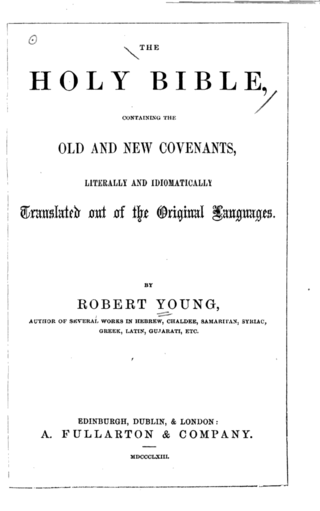
Young's Literal Translation (YLT) is a translation of the Bible into English, published in 1862. The translation was made by Robert Young, compiler of Young's Analytical Concordance to the Bible and Concise Critical Comments on the New Testament. Young used the Textus Receptus (TR) and the Masoretic Text (MT) as the basis for his translation. He wrote in the preface to the first edition, "It has been no part of the Translator's plan to attempt to form a New Hebrew or Greek Text—he has therefore somewhat rigidly adhered to the received ones." Young produced a "Revised Version" of his translation in 1887, but he stuck with the Received Text. He wrote in the preface to the Revised Edition, "The Greek Text followed is that generally recognized as the 'Received Text,' not because it is thought perfect, but because the department of Translation is quite distinct from that of textual criticism, and few are qualified for both. If the original text be altered by a translator, the reader is left in uncertainty whether the translation given is to be considered as that of the old or of the new reading." A new Revised Edition was released ten years after Robert Young's death on October 14, 1888. The 1898 version was based on the TR, easily confirmed by the word "bathe" in Revelation 1:5 and the word "again" in Revelation 20:5. The "Publishers' Note to the Third Edition" explains, "The work has been subjected to a fresh revision, making no alteration on the principles on which the Translation proceeds, but endeavouring to make it as nearly perfect in point of accuracy on its present lines as possible."
The Genesis creation narrative is the creation myth of both Judaism and Christianity. The narrative is made up of two stories, roughly equivalent to the first two chapters of the Book of Genesis. In the first, Elohim creates the heavens and the Earth in six days, then rests on, blesses, and sanctifies the seventh. In the second story God creates Adam, the first man, from dust and places him in the Garden of Eden. There he is given dominion over the animals. Eve, the first woman, is created from Adam's rib as his companion.
The Julia Evelina Smith Parker Translation is considered the first complete translation of the Bible into English by a woman. As of 2017, she is still the only woman to have translated the entire Bible unaided. The Bible was titled The Holy Bible: Containing the Old and New Testaments; Translated Literally from the Original Tongues, and was published in 1876.

Genesis 1:1 is the first verse of the first chapter of the Book of Genesis in the Hebrew and Christian Bibles and the opening of the Genesis creation narrative.
The Darby Bible refers to the Bible as translated from Hebrew and Greek by John Nelson Darby.

John 3 is the third chapter of the Gospel of John in the New Testament of the Christian Bible. It deals with Jesus' conversation with Nicodemus, one of the Jewish pharisees, and John the Baptist's continued testimony regarding Jesus. Baptist preacher Charles Spurgeon said of this chapter that it is the one he would choose "to read to a dying man who did not know the gospel, [as] the most suitable one for such an occasion".

Bereshit, Bereishit, Bereshis, Bereishis, or B'reshith is the first weekly Torah portion in the annual Jewish cycle of Torah reading. The parashah consists of Genesis 1:1–6:8.
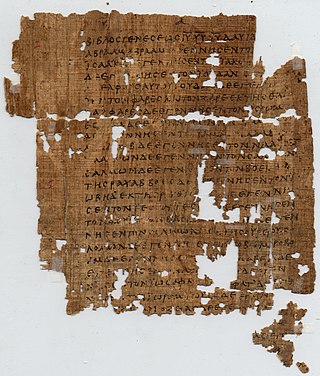
Matthew 24 is the twenty-fourth chapter of the Gospel of Matthew in the New Testament of the Christian Bible. It commences the Olivet Discourse or "Little Apocalypse" spoken by Jesus Christ, also described as the Eschatological Discourse, which continues into chapter 25. It contains Jesus' prediction of the destruction of the Temple in Jerusalem. Mark 13 and Luke 21 also cover the same material.

Adam is the name given in Genesis 1-5 to the first human.
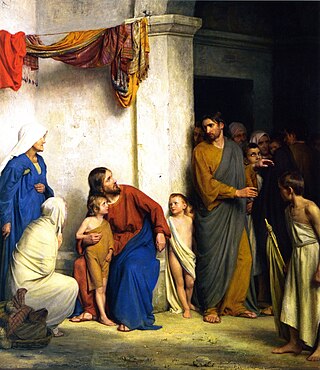
Chapter 18 of the Gospel of Matthew contains the fourth of the five Discourses of Matthew, also called the Discourse on the Church or the ecclesiastical discourse. It compares "the greatest in the Kingdom of Heaven" to a child, and also includes the parables of the lost sheep and the unforgiving servant, the second of which also refers to the Kingdom of Heaven. The general theme of the discourse is the anticipation of a future community of followers, and the role of his apostles in leading it.

Tohu wa-bohu or Tohu va-Vohu is a Biblical Hebrew phrase found in the Genesis creation narrative that describes the condition of the earth immediately before the creation of light in Genesis 1:3.
The phrase "Armor of God" is derived from Ephesians 6:11: "Put on the whole armour of God, that ye may be able to stand against the wiles of the devil.". As a biblical reference, the metaphor may refer to physical armour worn by God in metaphorical battles, or it may refer to vigilant righteousness in general as bestowed by the grace of God : "The night is far spent, the day is at hand: let us therefore cast off the works of darkness, and let us put on the armour of light."
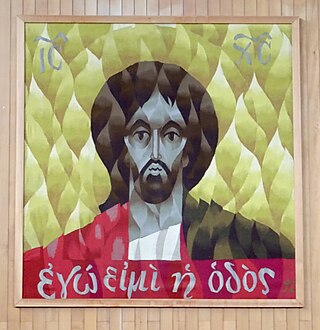
The Koine Greek term Ego eimi, literally 'I am' or 'It is I', is an emphatic form of the copulative verb εἰμι that is recorded in the Gospels to have been spoken by Jesus on several occasions to refer to himself not with the role of a verb but playing the role of a name, in the Gospel of John occurring seven times with specific titles. It is connected to the passage in Exodus 3:14 in which God gives his name as אֶהְיֶה אֲשֶׁר אֶהְיֶה, Ehyeh Asher Ehyeh, translated most basically as "I am that I am" or "I shall be what I am". In the Hebrew Bible, it is the personal name of God, revealed directly to Moses. These usages have been the subject of significant Christological analysis.
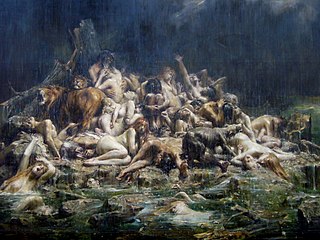
The Genesis flood narrative is a Hebrew flood myth. It tells of God's decision to return the universe to its pre-creation state of watery chaos and remake it through the microcosm of Noah's ark.
Textual variants in the Book of Genesis concerns textual variants in the Hebrew Bible found in the Book of Genesis.